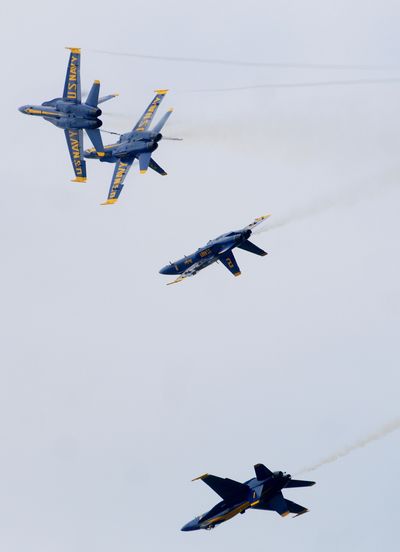Air shows offer cheap thrills
Attendance up as families limit spending

LOS ANGELES – Recession-weary families looking for affordable entertainment are increasingly turning to air shows as a source of cheap thrills, served up with a dollop of red, white and blue.
While theme parks and other family entertainment venues struggle for business in the slumping economy, attendance at air shows is up substantially in 2009 – by double-digit percentages at some venues.
And it’s not hard to see why. Getting two adults and two sub-10-year-olds through the gate at Disneyland for a day costs $256 without a discount coupon.
Getting the same group into the day-long air show at California’s El Centro Naval Air Facility in March – which featured a performance by the Blue Angels, the rock stars of the air show world – would have cost, well, nothing. Air shows at military bases, which account for about one-third of the air shows that will be staged in North America this year, don’t charge admission, and the parking is usually free.
Even shows that charge admission – such as the Watsonville Fly-In & Air Show north of Monterey, Calif., this weekend – are a relative bargain. The industry’s average adult ticket price is $12.
“Compared to other types of entertainment, air shows still represent a good value,” said Bill Hamilton, general manager of the Planes of Fame Air Museum in Chino, Calif., where paid attendance at the annual air show last weekend was 20,000, up 35 percent over the year before.
The International Council of Air Shows, the industry’s trade group, estimates that 15 million people will attend air shows in North America this year, up from the typical annual attendance of 10 million to 12 million. The group says it saw the same pattern during the recessions of the early 1980s and early ’90s.
Besides being relatively inexpensive, air shows also have the advantage of ubiquity. With so many staged each year, most families can find one within reasonable driving time of home.
“People are trading down, and they’re trading local, and it just makes sense given this economy that that would happen,” said Carl Winston, director of San Diego State University’s hospitality and tourism management program.
He said it’s another reflection of the recession-induced “staycation” trend – the tendency for families to spend their vacations close to home, or even at home, to save money during hard times.
Air shows aren’t for folks seeking a contemplative getaway. With thunderous jet flybys, outrageous aerial stunts and a heavy dose of pyrotechnics, they’re as subtle as a sonic boom on a quiet Sunday afternoon.
“Like everything else in the entertainment world, air shows have evolved to meet the increased expectations of the audiences that come to the events,” said John Cudahy, president of the air show council. “We’re competing with the X Games and wrestling, so the ‘wow factor’ has gone up considerably.”
With their emphasis on military aviation – be it an appearance by the state-of-the-art F-22 Raptor or a simulated dogfight featuring World War II-era fighters – air shows also can appeal to a taxpayer’s patriotic side.
“When you watch the Blue Angels fly multimillion-dollar airplanes a foot and a half away from each other, it’s hard not to be inspired by that,” Cudahy said.